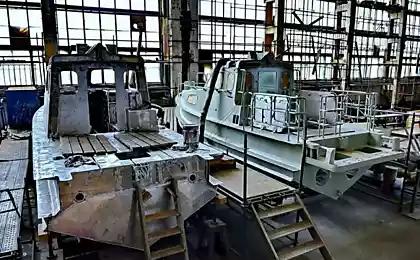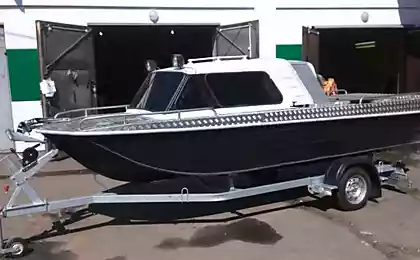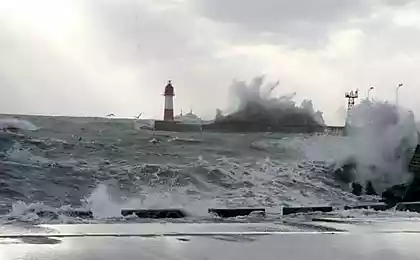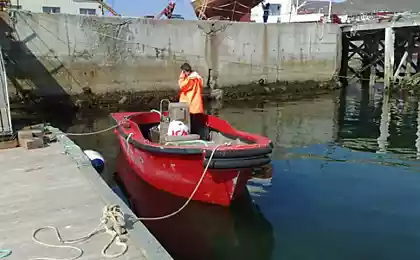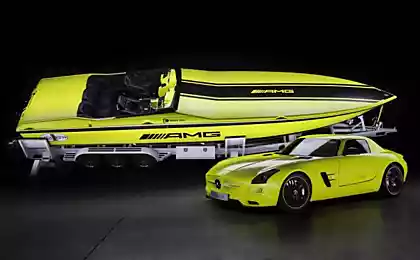1006
Diving-missile boats.
Please do not break! About okonochanii'll let you know.
The idea of personally handed the Secretary-General Nikita Khrushchev. Looking around once at a naval base in Balaklava speedboats projects CDB-19 and CDB-5 and observing based there as submarines, he suggested that in order to ensure stealth operations of the fleet, which is especially important in a nuclear war (and it was then considered a very real), we must seek to "plunge" into the water fleet, and offered to start the "plunge" into the water missile boat. He said it appeared that as if it's been great, if out of the water before the enemy will rocket ships, strike and break away from persecution at high speed, using hydrofoils or as effectively disappear again under water.
11 photo.

Development of the project in 1231 plunging the small missile ship was assigned to CDB-19 State Committee of USSR Council of Ministers on shipbuilding. Chief Designer was appointed bureau chief Igor Kostetsky. Under the development project CDB-19 was handed over to the Leningrad Naval plant as an experimental base construction and CDB. The important role played by the project in the organizational design of forces combining CDB-19 and CDB-5 in one office, later received the name Central Marine Design Bureau "Diamond". In connection with the merger of the two CB chief designer of the project in 1231 became head of the CDB-5 Eugene Yuhnin.
Designing such an unusual ship is a difficult task, as evidenced by himself the progress of work and a large number of intermediate stages of design, technical project ended experienced ship and layout of the main premises. The combination of conflicting requirements for surface ships and submarines, in one aspect, required the designers ingenuity and effort. It should be added that the design was carried out in katernom design bureau, which experts had to develop and design methods submarines.
The key to the design of any warship is alleged tactics of its combat use. Unfortunately, we can not say that the tactic of using sinking submarine was originally fully elaborated taking into account the possible actions alleged enemy and that the design of missile TTP was sufficiently substantiated. A more thorough examination of these tactics on the basis of the technical specifications for the design, composition and capabilities of weapons showed that the loss of the ships of the project on the battlefield will not be lower than the loss of high-speed missile boats that were at that time in the Navy. At the same time due to the high cost of sinking submarines compared to conventional military and economic effect of their use is questionable.

In accordance with the tactical and technical requirements the ship project in 1231 was intended to apply sudden missile strikes on warships and transport in narrow waters, on the approaches to naval bases and ports of the enemy, participate in the defense of the coast, areas of naval bases and the coastal flanks of the ground troops, reflection landings and breach enemy maritime communications, as well as to carry the sonar and radar surveillance in areas of basing the fleet dispersed. It was assumed that in solving these problems a group of such vessels should be deployed in a given area and for a long time to be submerged in the standby position or come with an opponent in a submerged position, keeping in touch with him by means of sonar. Having become acquainted, missile floated at high speed out to the line of rocket volley rockets, then sank or broke away from the enemy with the maximum speed on the surface. Being submerged submarines and a large speed of the attack were to reduce the time spent by enemy fire impact, including air attack.
To solve the problem in the design of the ship considered a large number of technical solutions for all major structural nodes. Armament was dramatically strengthened in relation to the originally specified (2 cruise missiles). The same can be said for radar and sonar. These measures are estimated to have halved the loss of ships of this project in the solution of combat missions.
Armament consisted of four cruise missiles P-25 with a range of 40 km, located in the singles, nenavodyaschihsya, unamortized launchers container type set at a constant angle of inclination to the horizon, with a remote control from a single console located in the control room of the ship. Launchers are outside the pressure hull and was sealed to pressure the maximum depth of immersion.
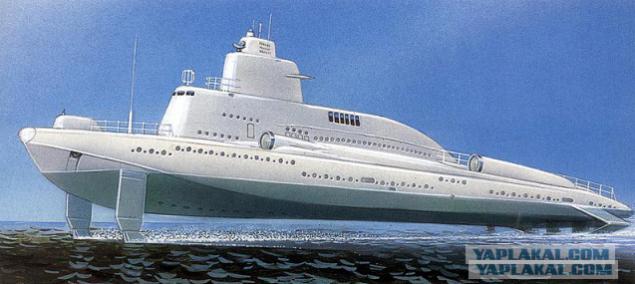
The development of anti-ship cruise missile R-25 (4K70 complex) was conducted in OKB-52 since 1960. Structurally it was a "smaller version" RCC "Amethyst" the same CB and easier starting unit designed for weapons boats. The rocket was planned installation of radar or heat seeker.
Continuous radar "mast-1231" provides detection and determination of coordinates of targets at a distance of 25-28 km. Sonar "Grayling" submerged without stroke allows you to detect the enemy at a distance of 60-120 km. Any means of self-defense, including defense against air attack, the ship did not have.
It should be noted that, for effective use of the range of the ship's radar missiles and were insufficient, as well as the efficiency of SAS motion. Lack of self-defense means significantly increased the probability of losing ships. The efficiency also reduces low-speed range and submerged speed and mode of RDP (diesel engines work under water). In addition, the depth of immersion was clearly insufficient for its successful defense against PLO funds.
In the design of the ship repeatedly varied common location number watertight compartments, their geometric shapes (in particular, the variants of accommodation space in isolated containers between which communication was possible only on the surface, cut a horizontal "eight", etc.) . Finally we stopped at two-compartment version in a robust housing. In the forward compartment located the control room, the room of electric power, posts radio operator and acoustics, battery and tank units. This compartment is all the control of the ship, engines, weapons, radar facilities, etc. In the second compartment housed the main and electric motors, diesel generator, hydraulic pumps, etc. The superstructure in a separate container is a solid residential bay with beds for 6 people, a galley and water reserves and provisions. Residential compartment provided also be used to rescue personnel from a submerged position. If it is damaged as it was possible to rescue from the central station (salvation anticipated manner of free ascent or buoy line). The superstructure located permeable pilot house, mine gas exhaust and air intake, the antenna.
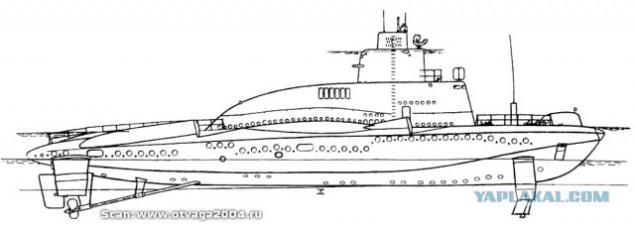
Since the beginning of the design of the ship as the primary method of providing high speed travel on the surface it has been accepted principle of movement hydrofoil. We investigated various combinations of hydrofoils and hull shapes from sharp bilge before planing boat. Testing of the hull shape and hydrofoil circuit being tested models in the towing tank, on the lake and in wind tunnels. The laborious process of optimizing the hydrodynamic arrangement ended in a technical presentation of the project three variants of its technical configuration: two hydrofoils, with one wing and the nose without any hydrofoils. Options were significantly different principal dimensions, displacement and speed of surface travel. Other major technical indicators were approximately equal. The most suitable for further development of a variant of one wing of the nose. Despite the lower speed, the characteristics of balancing and control submerged were better than those of a high-speed version with two hydrofoils (characteristic of cruise options - implementation of balancing and control of the ship in a vertical plane submerged by rotating the entire nose of the wing angle of attack).
As the main engines at various stages of the project were considered gas turbines with large aggregate power and diesel engines of various types and quantities without requiring large air intake shafts and having smaller dimensions. Adopted for the technical design of diesel M507 is an aggregate of two commercially cultivated diesels M504. For the rapid ascent of the ship provided for the possibility of blowing the main ballast tank exhaust gases of these engines.
In the design was carried out a large number of search elaborations in order to find an optimal transmission scheme, the power to the tracks during the course of the water and in the mode of RDP, including reversible electric machine "generator-motor", to a third shaft bevel gear, a hydraulic transmission pump and hydraulic motors. Finally it was chosen dvuhzalnaya installation with surface speed diesel engines and propulsion motors for underwater travel.
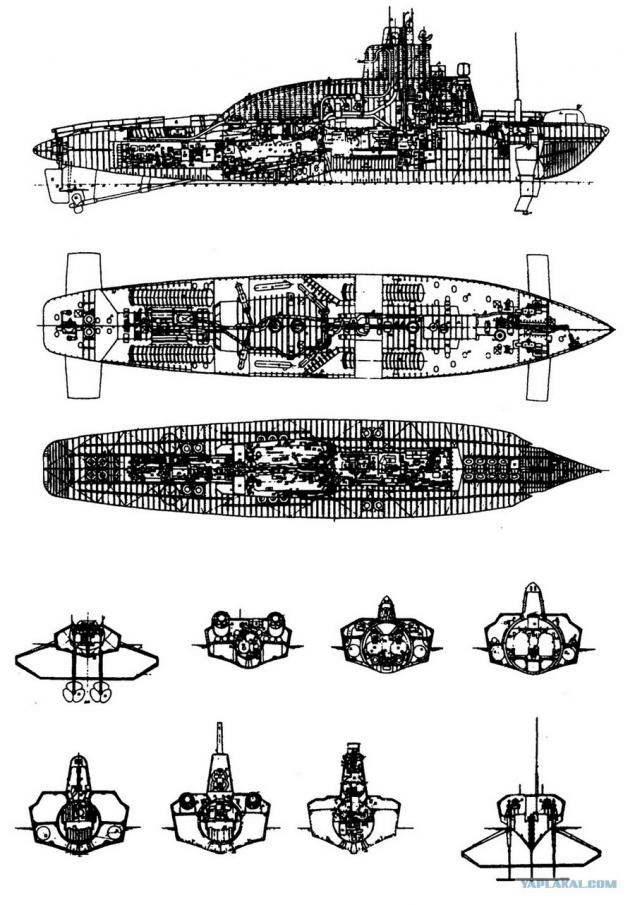
The power plant has been very complex and involves a large number of tools and devices. One only actuators of the remote automatic control, there were about 80 (with a corresponding communications network). However, the use of automatic control enabled, in particular, control the energy of the ship from the control room without finding personnel in the engine compartment.
The outer casing provided for entirely welded using extrusions and panels. Rugged technical project consisted of three cylindrical shell. And the middle part of the body different from the correct cylinder conventional submarines and is a few pair of inclined towers.
As a material for the outer shells and lasting considered various aluminum-magnesium alloys and high-strength steel for the wings - titanium and steel. For the hull finally chosen alloy AMg-61, for the wings - titanium. Durable hull has been designed to withstand loads in the explosion of a nuclear bomb within a radius of about 2 km (on a number of other systems and equipment - 4 km).
It turned out to be very complex vehicle systems. So, it is vitally important system of descent and ascent included 29 ventilation valves and 54 in Kingston. But the supply of high-pressure air is not sufficient to ship emergency ascent.
Describing the project as a whole, it should be noted that it was found a number of new technical solutions, such as: hull lines combined to ensure ride quality on the surface and underwater Stability Control; application for housing aluminum-magnesium alloy (with a thickness up to 40 mm) and for the wings - titanium; unusual structural design of hull; the use of new, yet to exhaust of diesel engines and silver-zinc batteries; the use of a large volume of automatic control of the ship and equipment, and the location of the actuators and the individual elements of automatic control wings, rudders, Kingston and ventilation valves of the ballast tanks outside the pressure hull; creating a lightweight and compact outboard fittings.
In addition, the had to go to important deviations from the established practices and design standards in shipbuilding, including zatesnenie general location, lack of access to some important devices, the rejection of measures to protect the ship and from the backup power source, the duplication of some elements of the power plant and ship systems (including drive systems, ascending and descending), congestion at the exit of the main engines of the ship on the wings, the limited reserves of stability and displacement, and a number of other derogations. Restrictions on the size and displacement resulted in the use of a number of small-sized and lightweight models of machinery and equipment of special systems and devices that have not yet been exploited commercially.
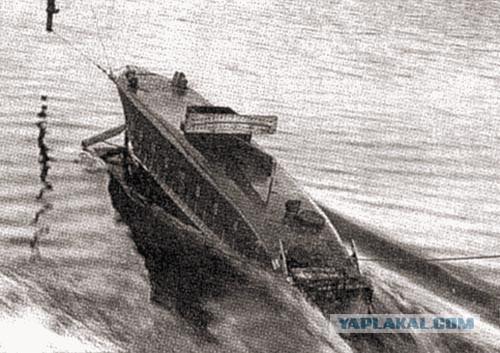
The complexity and novelty of a submerged submarine and later dictated a huge amount of design and development work, including studies of the hydrodynamic characteristics of the ship, a pilot test of body and wing structures, the development of new mechanisms, valves and other equipment, bench testing of the main engines and transmission mechanisms, automation and systems etc. (identified by the end of the list TEHPROEKT necessary work was about 120 items).
The deepening of the design process led to a constant increase in the mass of the ship, increase power plant capacity, etc. It was obvious that the further development of the project will inevitably be accompanied by an increase in displacement and hence a decrease in travel speed - characteristics that define, along with the very meaning of the creation of stealth ship.
Designing the submarine began in January 1959 and lasted until the end of 1964, when nursing NS Khrushchev from the political scene is automatically put an end to the work, which could hardly lead to real success, despite the dedication of the designers.

However, not Nikita Khrushchev was the author of the idea of a combat diving boats. The first draft of the proposed ship Valerian Brzezinski (1894-1985). In 1937, the largest naval figure and designer hit the "sharashka" - Special Technical Bureau of the NKVD at the factory number 196 in Leningrad. There, under his leadership, in 1939 the project was created sinking torpedo boat M-400 "Flea."
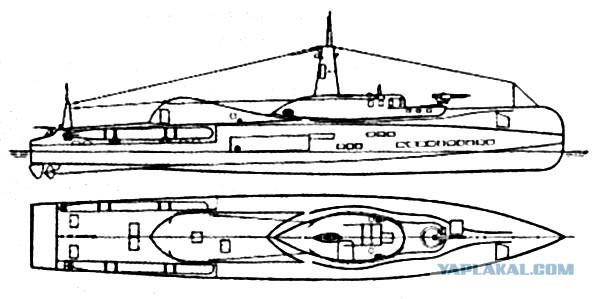
According to the draft, the ship at surface displacement of 35, 3 tons to reach speeds of 33 knots. And under water - 11 knots. (with a displacement - 74 m). He was armed with two 450-mm torpedo tubes and a machine gun. The power plant - two diesel engines, submerged working in a closed cycle. It was assumed that the submarine-boat submerged was to sneak up on the enemy and hit his torpedoes, and then emerge at full speed away from the pursuit of forces escort.
"Bloch" was laid on the plant. A. Marti in 1939. By the beginning of the war the technical readiness of the ship was about 60%. In besieged Leningrad in 1942 halted work on the boat, and then received from the shelling damage completely stopped and is not renewed.
The idea to create boats capable of some time to dive into the water, still alive. In the domestic and foreign press there are reports about the development of this type of ships, though not with such ambitious specifications as the project in 1231, and designed for civilian purposes.
Thus, the state small enterprise "Delfin" (St. Petersburg) in the late 1990s has drafted emersed-submarine boat. His appointment - quick delivery to the areas of the continental shelf (including dive up to 15 meters) of a group of divers (up to 6 pers.) With equipment, tools and equipment for the Inspection and repairs. The boat has a hull shape that allows to develop high-speed surface speed (up to 32 knots.), And acceptable handling at 2-3 knots. submerged. The main elements and characteristics of the boat: length - 6, 6 m, width - 2, 2 m, the height of the highest - 1, 3 m, draft - 0, 6 m, full displacement surfaced / submerged - 4/4, 4 tons; above-water cruising range - 100 miles, underwater - 4-5 miles, nautical - 4 points. Two rotary piston engine capacity of 2? 110 kW provide movement on the surface using water cannons. In the bow of the boat has two azimuth column for underwater travel.

St. Petersburg Marine Engineering Bureau "Malachite" project was created diving boat, capable of diving to a depth of 50-100 m. Its basic elements and characteristics: length - 30, width - 5 draft - 4, 8 meters, displacement - 300 ie, the rate of surface speed - 8 knots., underwater - 3 kt., the crew - 4 people. Six passengers are accommodated in three comfortable cabins, equipped with underwater portholes (800x800 mm).
Source:
The idea of personally handed the Secretary-General Nikita Khrushchev. Looking around once at a naval base in Balaklava speedboats projects CDB-19 and CDB-5 and observing based there as submarines, he suggested that in order to ensure stealth operations of the fleet, which is especially important in a nuclear war (and it was then considered a very real), we must seek to "plunge" into the water fleet, and offered to start the "plunge" into the water missile boat. He said it appeared that as if it's been great, if out of the water before the enemy will rocket ships, strike and break away from persecution at high speed, using hydrofoils or as effectively disappear again under water.
11 photo.

Development of the project in 1231 plunging the small missile ship was assigned to CDB-19 State Committee of USSR Council of Ministers on shipbuilding. Chief Designer was appointed bureau chief Igor Kostetsky. Under the development project CDB-19 was handed over to the Leningrad Naval plant as an experimental base construction and CDB. The important role played by the project in the organizational design of forces combining CDB-19 and CDB-5 in one office, later received the name Central Marine Design Bureau "Diamond". In connection with the merger of the two CB chief designer of the project in 1231 became head of the CDB-5 Eugene Yuhnin.
Designing such an unusual ship is a difficult task, as evidenced by himself the progress of work and a large number of intermediate stages of design, technical project ended experienced ship and layout of the main premises. The combination of conflicting requirements for surface ships and submarines, in one aspect, required the designers ingenuity and effort. It should be added that the design was carried out in katernom design bureau, which experts had to develop and design methods submarines.
The key to the design of any warship is alleged tactics of its combat use. Unfortunately, we can not say that the tactic of using sinking submarine was originally fully elaborated taking into account the possible actions alleged enemy and that the design of missile TTP was sufficiently substantiated. A more thorough examination of these tactics on the basis of the technical specifications for the design, composition and capabilities of weapons showed that the loss of the ships of the project on the battlefield will not be lower than the loss of high-speed missile boats that were at that time in the Navy. At the same time due to the high cost of sinking submarines compared to conventional military and economic effect of their use is questionable.

In accordance with the tactical and technical requirements the ship project in 1231 was intended to apply sudden missile strikes on warships and transport in narrow waters, on the approaches to naval bases and ports of the enemy, participate in the defense of the coast, areas of naval bases and the coastal flanks of the ground troops, reflection landings and breach enemy maritime communications, as well as to carry the sonar and radar surveillance in areas of basing the fleet dispersed. It was assumed that in solving these problems a group of such vessels should be deployed in a given area and for a long time to be submerged in the standby position or come with an opponent in a submerged position, keeping in touch with him by means of sonar. Having become acquainted, missile floated at high speed out to the line of rocket volley rockets, then sank or broke away from the enemy with the maximum speed on the surface. Being submerged submarines and a large speed of the attack were to reduce the time spent by enemy fire impact, including air attack.
To solve the problem in the design of the ship considered a large number of technical solutions for all major structural nodes. Armament was dramatically strengthened in relation to the originally specified (2 cruise missiles). The same can be said for radar and sonar. These measures are estimated to have halved the loss of ships of this project in the solution of combat missions.
Armament consisted of four cruise missiles P-25 with a range of 40 km, located in the singles, nenavodyaschihsya, unamortized launchers container type set at a constant angle of inclination to the horizon, with a remote control from a single console located in the control room of the ship. Launchers are outside the pressure hull and was sealed to pressure the maximum depth of immersion.

The development of anti-ship cruise missile R-25 (4K70 complex) was conducted in OKB-52 since 1960. Structurally it was a "smaller version" RCC "Amethyst" the same CB and easier starting unit designed for weapons boats. The rocket was planned installation of radar or heat seeker.
Continuous radar "mast-1231" provides detection and determination of coordinates of targets at a distance of 25-28 km. Sonar "Grayling" submerged without stroke allows you to detect the enemy at a distance of 60-120 km. Any means of self-defense, including defense against air attack, the ship did not have.
It should be noted that, for effective use of the range of the ship's radar missiles and were insufficient, as well as the efficiency of SAS motion. Lack of self-defense means significantly increased the probability of losing ships. The efficiency also reduces low-speed range and submerged speed and mode of RDP (diesel engines work under water). In addition, the depth of immersion was clearly insufficient for its successful defense against PLO funds.
In the design of the ship repeatedly varied common location number watertight compartments, their geometric shapes (in particular, the variants of accommodation space in isolated containers between which communication was possible only on the surface, cut a horizontal "eight", etc.) . Finally we stopped at two-compartment version in a robust housing. In the forward compartment located the control room, the room of electric power, posts radio operator and acoustics, battery and tank units. This compartment is all the control of the ship, engines, weapons, radar facilities, etc. In the second compartment housed the main and electric motors, diesel generator, hydraulic pumps, etc. The superstructure in a separate container is a solid residential bay with beds for 6 people, a galley and water reserves and provisions. Residential compartment provided also be used to rescue personnel from a submerged position. If it is damaged as it was possible to rescue from the central station (salvation anticipated manner of free ascent or buoy line). The superstructure located permeable pilot house, mine gas exhaust and air intake, the antenna.

Since the beginning of the design of the ship as the primary method of providing high speed travel on the surface it has been accepted principle of movement hydrofoil. We investigated various combinations of hydrofoils and hull shapes from sharp bilge before planing boat. Testing of the hull shape and hydrofoil circuit being tested models in the towing tank, on the lake and in wind tunnels. The laborious process of optimizing the hydrodynamic arrangement ended in a technical presentation of the project three variants of its technical configuration: two hydrofoils, with one wing and the nose without any hydrofoils. Options were significantly different principal dimensions, displacement and speed of surface travel. Other major technical indicators were approximately equal. The most suitable for further development of a variant of one wing of the nose. Despite the lower speed, the characteristics of balancing and control submerged were better than those of a high-speed version with two hydrofoils (characteristic of cruise options - implementation of balancing and control of the ship in a vertical plane submerged by rotating the entire nose of the wing angle of attack).
As the main engines at various stages of the project were considered gas turbines with large aggregate power and diesel engines of various types and quantities without requiring large air intake shafts and having smaller dimensions. Adopted for the technical design of diesel M507 is an aggregate of two commercially cultivated diesels M504. For the rapid ascent of the ship provided for the possibility of blowing the main ballast tank exhaust gases of these engines.
In the design was carried out a large number of search elaborations in order to find an optimal transmission scheme, the power to the tracks during the course of the water and in the mode of RDP, including reversible electric machine "generator-motor", to a third shaft bevel gear, a hydraulic transmission pump and hydraulic motors. Finally it was chosen dvuhzalnaya installation with surface speed diesel engines and propulsion motors for underwater travel.

The power plant has been very complex and involves a large number of tools and devices. One only actuators of the remote automatic control, there were about 80 (with a corresponding communications network). However, the use of automatic control enabled, in particular, control the energy of the ship from the control room without finding personnel in the engine compartment.
The outer casing provided for entirely welded using extrusions and panels. Rugged technical project consisted of three cylindrical shell. And the middle part of the body different from the correct cylinder conventional submarines and is a few pair of inclined towers.
As a material for the outer shells and lasting considered various aluminum-magnesium alloys and high-strength steel for the wings - titanium and steel. For the hull finally chosen alloy AMg-61, for the wings - titanium. Durable hull has been designed to withstand loads in the explosion of a nuclear bomb within a radius of about 2 km (on a number of other systems and equipment - 4 km).
It turned out to be very complex vehicle systems. So, it is vitally important system of descent and ascent included 29 ventilation valves and 54 in Kingston. But the supply of high-pressure air is not sufficient to ship emergency ascent.
Describing the project as a whole, it should be noted that it was found a number of new technical solutions, such as: hull lines combined to ensure ride quality on the surface and underwater Stability Control; application for housing aluminum-magnesium alloy (with a thickness up to 40 mm) and for the wings - titanium; unusual structural design of hull; the use of new, yet to exhaust of diesel engines and silver-zinc batteries; the use of a large volume of automatic control of the ship and equipment, and the location of the actuators and the individual elements of automatic control wings, rudders, Kingston and ventilation valves of the ballast tanks outside the pressure hull; creating a lightweight and compact outboard fittings.
In addition, the had to go to important deviations from the established practices and design standards in shipbuilding, including zatesnenie general location, lack of access to some important devices, the rejection of measures to protect the ship and from the backup power source, the duplication of some elements of the power plant and ship systems (including drive systems, ascending and descending), congestion at the exit of the main engines of the ship on the wings, the limited reserves of stability and displacement, and a number of other derogations. Restrictions on the size and displacement resulted in the use of a number of small-sized and lightweight models of machinery and equipment of special systems and devices that have not yet been exploited commercially.

The complexity and novelty of a submerged submarine and later dictated a huge amount of design and development work, including studies of the hydrodynamic characteristics of the ship, a pilot test of body and wing structures, the development of new mechanisms, valves and other equipment, bench testing of the main engines and transmission mechanisms, automation and systems etc. (identified by the end of the list TEHPROEKT necessary work was about 120 items).
The deepening of the design process led to a constant increase in the mass of the ship, increase power plant capacity, etc. It was obvious that the further development of the project will inevitably be accompanied by an increase in displacement and hence a decrease in travel speed - characteristics that define, along with the very meaning of the creation of stealth ship.
Designing the submarine began in January 1959 and lasted until the end of 1964, when nursing NS Khrushchev from the political scene is automatically put an end to the work, which could hardly lead to real success, despite the dedication of the designers.

However, not Nikita Khrushchev was the author of the idea of a combat diving boats. The first draft of the proposed ship Valerian Brzezinski (1894-1985). In 1937, the largest naval figure and designer hit the "sharashka" - Special Technical Bureau of the NKVD at the factory number 196 in Leningrad. There, under his leadership, in 1939 the project was created sinking torpedo boat M-400 "Flea."

According to the draft, the ship at surface displacement of 35, 3 tons to reach speeds of 33 knots. And under water - 11 knots. (with a displacement - 74 m). He was armed with two 450-mm torpedo tubes and a machine gun. The power plant - two diesel engines, submerged working in a closed cycle. It was assumed that the submarine-boat submerged was to sneak up on the enemy and hit his torpedoes, and then emerge at full speed away from the pursuit of forces escort.
"Bloch" was laid on the plant. A. Marti in 1939. By the beginning of the war the technical readiness of the ship was about 60%. In besieged Leningrad in 1942 halted work on the boat, and then received from the shelling damage completely stopped and is not renewed.
The idea to create boats capable of some time to dive into the water, still alive. In the domestic and foreign press there are reports about the development of this type of ships, though not with such ambitious specifications as the project in 1231, and designed for civilian purposes.
Thus, the state small enterprise "Delfin" (St. Petersburg) in the late 1990s has drafted emersed-submarine boat. His appointment - quick delivery to the areas of the continental shelf (including dive up to 15 meters) of a group of divers (up to 6 pers.) With equipment, tools and equipment for the Inspection and repairs. The boat has a hull shape that allows to develop high-speed surface speed (up to 32 knots.), And acceptable handling at 2-3 knots. submerged. The main elements and characteristics of the boat: length - 6, 6 m, width - 2, 2 m, the height of the highest - 1, 3 m, draft - 0, 6 m, full displacement surfaced / submerged - 4/4, 4 tons; above-water cruising range - 100 miles, underwater - 4-5 miles, nautical - 4 points. Two rotary piston engine capacity of 2? 110 kW provide movement on the surface using water cannons. In the bow of the boat has two azimuth column for underwater travel.

St. Petersburg Marine Engineering Bureau "Malachite" project was created diving boat, capable of diving to a depth of 50-100 m. Its basic elements and characteristics: length - 30, width - 5 draft - 4, 8 meters, displacement - 300 ie, the rate of surface speed - 8 knots., underwater - 3 kt., the crew - 4 people. Six passengers are accommodated in three comfortable cabins, equipped with underwater portholes (800x800 mm).
Source:






